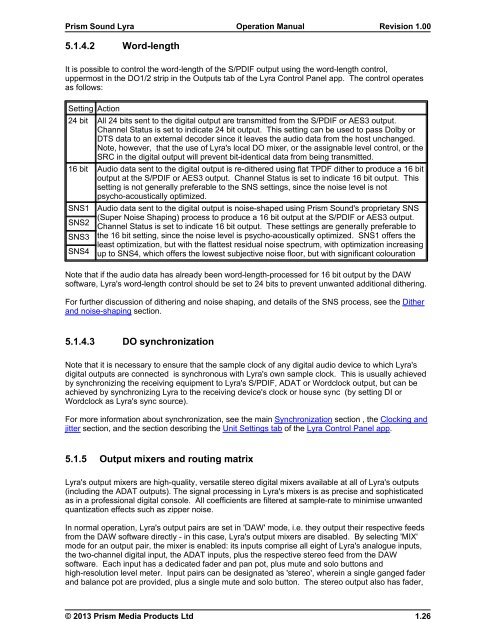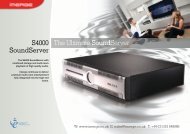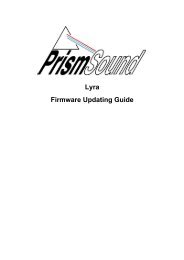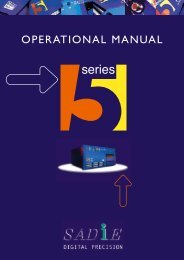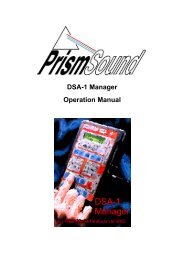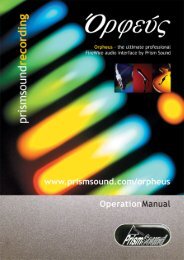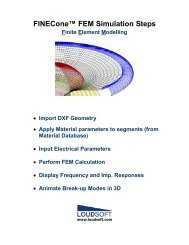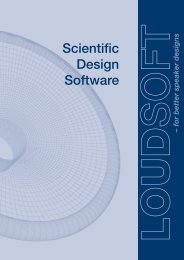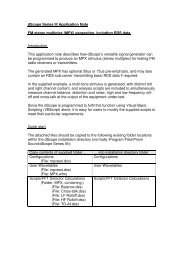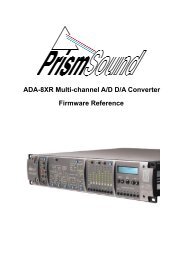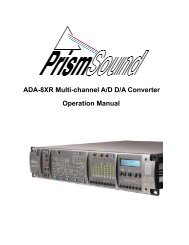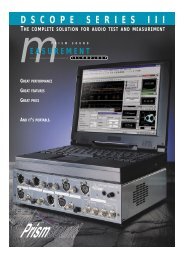Lyra Operation Manual - Test and Measurement - Prism Sound
Lyra Operation Manual - Test and Measurement - Prism Sound
Lyra Operation Manual - Test and Measurement - Prism Sound
- No tags were found...
Create successful ePaper yourself
Turn your PDF publications into a flip-book with our unique Google optimized e-Paper software.
<strong>Prism</strong> <strong>Sound</strong> <strong>Lyra</strong>5.1.4.2 Word-length<strong>Operation</strong> <strong>Manual</strong>Revision 1.00It is possible to control the word-length of the S/PDIF output using the word-length control,uppermost in the DO1/2 strip in the Outputs tab of the <strong>Lyra</strong> Control Panel app. The control operatesas follows:Setting Action24 bit All 24 bits sent to the digital output are transmitted from the S/PDIF or AES3 output.Channel Status is set to indicate 24 bit output. This setting can be used to pass Dolby orDTS data to an external decoder since it leaves the audio data from the host unchanged.Note, however, that the use of <strong>Lyra</strong>'s local DO mixer, or the assignable level control, or theSRC in the digital output will prevent bit-identical data from being transmitted.16 bit Audio data sent to the digital output is re-dithered using flat TPDF dither to produce a 16 bitoutput at the S/PDIF or AES3 output. Channel Status is set to indicate 16 bit output. Thissetting is not generally preferable to the SNS settings, since the noise level is notpsycho-acoustically optimized.SNS1SNS2SNS3SNS4Audio data sent to the digital output is noise-shaped using <strong>Prism</strong> <strong>Sound</strong>'s proprietary SNS(Super Noise Shaping) process to produce a 16 bit output at the S/PDIF or AES3 output.Channel Status is set to indicate 16 bit output. These settings are generally preferable tothe 16 bit setting, since the noise level is psycho-acoustically optimized. SNS1 offers theleast optimization, but with the flattest residual noise spectrum, with optimization increasingup to SNS4, which offers the lowest subjective noise floor, but with significant colourationNote that if the audio data has already been word-length-processed for 16 bit output by the DAWsoftware, <strong>Lyra</strong>'s word-length control should be set to 24 bits to prevent unwanted additional dithering.For further discussion of dithering <strong>and</strong> noise shaping, <strong>and</strong> details of the SNS process, see the Dither<strong>and</strong> noise-shaping section.5.1.4.3 DO synchronizationNote that it is necessary to ensure that the sample clock of any digital audio device to which <strong>Lyra</strong>'sdigital outputs are connected is synchronous with <strong>Lyra</strong>'s own sample clock. This is usually achievedby synchronizing the receiving equipment to <strong>Lyra</strong>'s S/PDIF, ADAT or Wordclock output, but can beachieved by synchronizing <strong>Lyra</strong> to the receiving device's clock or house sync (by setting DI orWordclock as <strong>Lyra</strong>'s sync source).For more information about synchronization, see the main Synchronization section , the Clocking <strong>and</strong>jitter section, <strong>and</strong> the section describing the Unit Settings tab of the <strong>Lyra</strong> Control Panel app.5.1.5 Output mixers <strong>and</strong> routing matrix<strong>Lyra</strong>'s output mixers are high-quality, versatile stereo digital mixers available at all of <strong>Lyra</strong>'s outputs(including the ADAT outputs). The signal processing in <strong>Lyra</strong>'s mixers is as precise <strong>and</strong> sophisticatedas in a professional digital console. All coefficients are filtered at sample-rate to minimise unwantedquantization effects such as zipper noise.In normal operation, <strong>Lyra</strong>'s output pairs are set in 'DAW' mode, i.e. they output their respective feedsfrom the DAW software directly - in this case, <strong>Lyra</strong>'s output mixers are disabled. By selecting 'MIX'mode for an output pair, the mixer is enabled: its inputs comprise all eight of <strong>Lyra</strong>'s analogue inputs,the two-channel digital input, the ADAT inputs, plus the respective stereo feed from the DAWsoftware. Each input has a dedicated fader <strong>and</strong> pan pot, plus mute <strong>and</strong> solo buttons <strong>and</strong>high-resolution level meter. Input pairs can be designated as 'stereo', wherein a single ganged fader<strong>and</strong> balance pot are provided, plus a single mute <strong>and</strong> solo button. The stereo output also has fader,© 2013 <strong>Prism</strong> Media Products Ltd1.26


